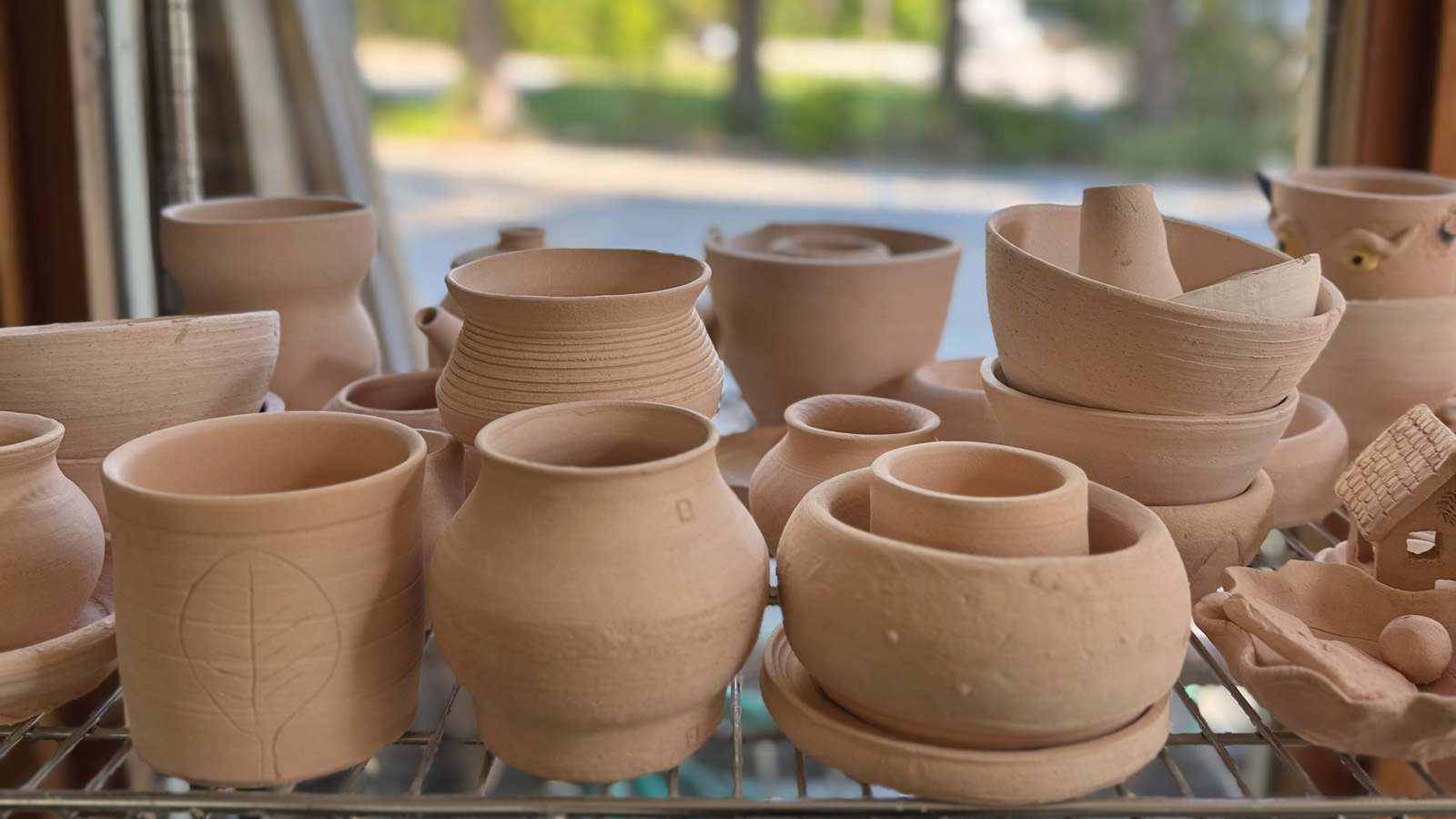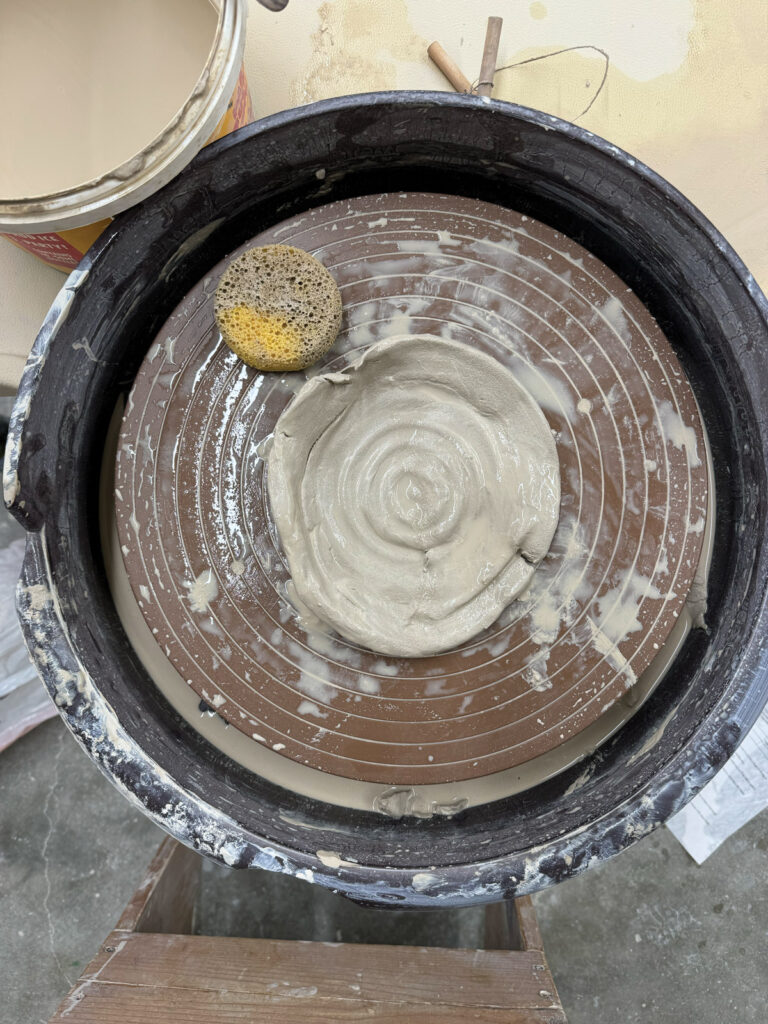Creating Something From Nothing
- "Creating Something From Nothing" originally appeared in the November 2024 "Impact" issue of COMO Magazine.

A journey with clay wheel throwing at Access Arts.
There’s a moment when you sit in front of a pottery wheel, feeling its cool metal surface under your fingers, and realize you’re about to create something from nothing. For someone like me, and perhaps most of us, we want to do things well the first time. But clay wheel throwing isn’t something you can master with copious notes or meticulous observation. It’s a craft that demands your presence, a skill that grows as you allow your hands to lead the way rather than your mind.
And that’s the beauty of stepping out of your comfort zone — it forces you to get creative, to let go, and to discover new parts of yourself.
I decided to take the plunge with a six-week ceramics class at Access Arts, a local nonprofit in Columbia that has been fostering creativity and community. Under the gentle guidance of instructors like Sophie Lever, an artist-in-residence passionate about teaching, I began my journey with wheel throwing.
Feeling the Process, Not Controlling It
Stepping into the ceramics studio, I felt an anxious and exciting energy. As Sophie instructed during the first session, “You can’t control the clay. It will do what it wants. You have to feel your way through it.” Her words stuck with me, like a reminder that art — and maybe life — requires a certain level of surrender.
In the first few rounds of shaping the clay, I caught myself gripping it too tightly, trying to force it into something it wasn’t ready to become. The wheel spun underneath my hands, the wet clay wobbling unpredictably, resisting my attempts to tame it.
“Don’t fight it,” Sophie would say, her voice encouraging. “Let it guide you.”
People can enter a strange, almost meditative state when working with clay. The more I focused on letting go — of controlling every movement, every outcome — the better the experience became. Classmates would agree, “Just enjoy the clay and have fun.” And strangely, the best results happened when I stopped trying to be perfect. Instead, I seemed to possess more childlike tendencies, where creation is pure joy, unburdened by critique.
The Freedom of Imperfection
At a couple of open studio sessions, I admired other students in the room who were designing beautiful bowls and cylinder vases. It’s hard to focus on your newcomer lane and be gentle about the developmental process when others are mastering their skills. You must step back and appreciate the dedication to the practice, and you are simply a new student learning a new practice.
I found myself imagining the ancient pottery markets of Sri Lanka. Artisans spent their entire lives honing their craft, passing down knowledge through generations. I envisioned the vibrancy of the clay market stalls, each shop filled with pieces that told stories of commitment, community, and years of practice. I wondered if those potters, with all their skill, ever experienced the same satisfaction I felt when a lopsided bowl finally took shape.

The imperfections in my work felt like a reflection of my learning process, and I embraced them.
As the wheel spun, I noticed that my brain, once tangled with overthinking and self-criticism, started to quiet. The act of shaping clay was an escape from the usual distractions and noise of life. It was a revelation — the act of creating and just enjoying the present, especially something tactile and tangible, was a way of discovering new ways to be kinder to myself by letting things float away.
The Satisfying, Messy Reality
On a less lofty level, the process of wheel throwing is undeniably messy. There’s something deeply satisfying, though, about plunging your hands into the slick, cool clay, feeling it squish and mold between your fingers. It’s gross, sure, but it’s also an incredibly grounding experience. I would leave class with clay smudged on my clothes, under my nails, and in my hair, but each smear felt like a badge of honor, proof that I was learning by doing.
As Sarah Catlin, the executive director of Access Arts, told me, “It’s always rewarding to see people who say ‘I’m not good at art,’ and then they come to a class and make something incredible.”
That’s exactly what happened to me, but more on the amateur level. I’m not opening an Etsy shop anytime soon. By the end of each class, I would look down at my hands—stained with clay but also with newfound confidence. The more I let myself play, the more my creations started to resemble actual pottery.
Fixing Mistakes
One of the most valuable lessons I learned from Sophie and the team at Access Arts was how to fix my mistakes with the understanding that mistakes are guaranteed. Like many supportive instructors, Sophie didn’t rush to correct me when I made an error. Instead, she allowed me to figure it out independently, giving just enough guidance to steer me back on track. “It’s not going to be easy,” she reminded us one evening. “No one is good right away. But that makes art exciting — it’s better to make something than nothing.”
There were countless times when I thought I had ruined a piece — when the clay collapsed in on itself or wobbled out of shape. But each time, I learned something new about the material and about myself. Pottery teaches patience. The process forces a person to slow down and accept that not everything will go according to plan. And when it does go wrong, there is always a chance to start again, to reshape the clay, and to improve.
A Creative Hub
Access Arts has become a creative sanctuary for people looking to stretch beyond their usual boundaries. Founded in 1971 and gaining nonprofit status in 1974, it has grown into a space where aspiring and seasoned artists can explore their creativity through ceramics, weaving, spinning, and more. Sarah proudly spoke about the center’s work with military veterans and children at Benton Elementary through their free after-school art club.
“We want people to discover that they can create incredible things, no matter what they’ve been told,” she said.
Sophie’s residency at Access Arts was another element of the studio’s magic. She moved to Columbia earlier this year after completing a year-long artist-in-residency program in Brockway, Pennsylvania. Additionally, she practiced her ceramics skills at a community studio in New York while attending a college without a ceramics class. Her love for teaching was evident in working with the high schoolers in the after-school program and with adults like me. Each class was a mix of guided instruction and space to experiment, a balance that allowed for learning and creativity to flow naturally.
Letting Go, Creating More
By the end of my six-week session, I made a few wonky bowls, a lopsided cup, and a misshapen plate. But more importantly, I found a new creative outlet that helped me step outside of my comfort zone and feel freedom, similar to those childhood craft times. It’s easy to get caught up in the details, in the need to create something perfect. When letting go of that pressure for perfectionism, you open yourself up to discoveries.
As Sophie said during our last class, “The best advice I can give is to keep doing it. It’s better to make something than nothing.” I realized that her advice didn’t just apply to ceramics — it was a lesson for life. Whether you’re shaping clay or navigating a new direction, the key is to keep going, to embrace the mistakes, and to find joy in the process.
If you’re looking to break out of your comfort zone, consider getting your hands dirty. You might just find that the less you care about perfection, the more beautiful things you’ll create.
Check Access Art’s offers on its website, including weekly adult ceramics classes, weekly fibers classes, and date nights. Registration for the November/December class series are open — and they will fill up quickly.








